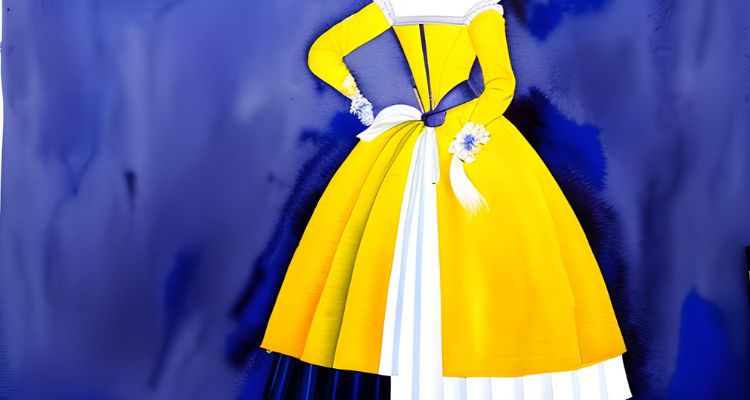Discover the cultural, social, and historical influences on fashion in the 1560s. The significant social and political events that occurred during this time in England and Europe led to a broad and vibrant fashion scene, with new trends constantly emerging and traditional ones evolving. From elaborate dresses made of lavish materials to more practical designs that allowed for greater movement and adaptability, influences on fashion in the 1560s reflected changing attitudes toward class, gender, and power. Both Protestants and Catholics used clothing to express their religious beliefs, which had a significant impact on fashion trends. Today, fashion designers draw inspiration from the past to create fresh and unique styles, and investigating the influences on fashion in the 1560s can provide insight into the trends that continue to shape our modern fashion industry.

I. Social and Political Influences
Fashion has always mirrored the civilization in which it exists, Influences on Fashion in the 1560s was no exception. The period’s social and political developments had a profound influence on fashion, influencing both men’s and women’s clothing choices. The cultural and political influences of the time were reflected in fashion patterns, from shifts in class perspectives to gender role modifications.
Changing Attitudes Towards Class
During the Influences on Fashion in the 1560s, there was a shift in attitudes toward class, with the rise of the merchant class and the decline of the aristocracy. This change was reflected in the clothing styles of the time, as the wealthy merchant class began to adopt more luxurious fabrics and elaborate designs previously reserved for the nobility. Wealthy merchants began to dress in more ornate clothing, featuring intricate embroidery and sumptuous fabrics such as silk and velvet. Meanwhile, the aristocracy began to adopt more understated clothing styles, reflecting the decline of their social status.
Gender Roles
In the Influences on Fashion in the 1560s, gender roles shifted, with women enjoying greater freedom and independence than in previous centuries. This trend was paralleled in historical dress designs, as women began to wear clothing that allowed for more flexibility of movement and was less constricting. Gowns grew more tailored and less voluminous, allowing for better movement. Women began to wear more male clothes, such as doublets and breeches, to demonstrate their independence and break away from traditional gender stereotypes.
Power and Politics
The political situation of the 1560s affected dress trends as well. Clothing fashions were highly politicized during Elizabeth I’s reign while England was immersed in political strife. With lavish costumes and clothing, designs meant to wow and terrify, the queen herself utilized fashion to impose her dominance and influence over her subjects. Influences on Fashion in the 1560s Clothing trends of the time also mirrored the continuing war between Catholics and Protestants, with both sides expressing their religious views and allegiances via dress.
II. Economic Influences
The 1560s saw significant economic development, with the rise of the merchant class and the expansion of international trade opening up new opportunities and problems for European economies. As clothing patterns grew increasingly impacted by global commerce and the availability of new materials and textiles, these economic shifts had a huge impact on fashion trends of the time.
Global Trade and the Rise of the Merchant Class
The expansion of foreign trade in the 1560s increased the availability of new materials and textiles, which had a considerable influence on fashion trends. With the rise of the merchant class, who were at the forefront of this trade, new dress designs evolved that reflected their wealth and status. These new fashions included more complex and costly clothing designs with exquisite needlework and luscious materials like silk and velvet.
The Influence of Textile Production
The expansion of textile production has a considerable influence on current fashion trends. With the development of new production processes, it became feasible to make textiles and materials more swiftly and effectively than ever before. As a result, new textiles, such as fine cotton and linen, became available and were used to produce new clothing designs that were both useful and fashionable.
The Impact of the Wool Trade
The expansion of textile production has a considerable influence on current fashion trends. With the development of new production processes, it became feasible to make textiles and materials more swiftly and effectively than ever before. As a result, new materials became accessible, such as fine cotton and linen, which were utilized to create new clothing styles that were both functional and stylish.
III. Cultural Influences
The 1560s saw significant cultural upheaval, with evolving attitudes regarding art, literature, and music. As clothing patterns grew increasingly impacted by cultural and creative movements, these developments had a profound impact on fashion trends of the period.

Renaissance Art and Literature
During the 1560s, the Renaissance was in full flow, and the art and literature of the time had a huge influence on fashion trends. The popularity of classical art and literature, for example, sparked an interest in clothing styles that reflected classical ideals of beauty and proportion. This resulted in the creation of new clothing styles with a more structured silhouette, as well as clothing designed to flatter the natural lines of the body.
The Impact of Royal Patronage
Throughout the 1560s, royal sponsorship also had a considerable effect on dress trends. For example, Queen Elizabeth I of England was noted for her lavish and magnificent costumes, which were meant to show her riches and rank. These dresses had a huge impact on fashion trends of the period, including exquisite embroidery and rich materials like silk and velvet.
Religious Influences
Throughout the 1560s, the continuous strife between Catholics and Protestants had a considerable influence on design trends. Protestants preferred more simple and functional dress designs, whilst Catholics preferred more elaborate and decorative clothing styles that indicated their riches and rank.
IV. Foreign Influences
The 1560s saw substantial worldwide trade and cultural interchange, with European nations contending for trade and colonial control. These encounters with different cultures had a profound impact on fashion trends at the period, as clothing styles grew increasingly influenced by exotic materials, patterns, and motifs from faraway regions.
The Impact of Trade with the Ottoman Empire
Trade with the Ottoman Empire had a significant impact on fashion trends during the 1560s. Ottoman silks and textiles were highly sought after in Europe, and the distinctive designs and patterns of Ottoman textiles influenced fashion trends of the time. Clothing styles began to feature bold colors and intricate patterns, with fabrics such as damask and brocade becoming increasingly popular.
The Influence of Asian Textiles
Throughout the 1560s, Asian textiles had a profound impact on fashion trends. Trade with China and India made new textiles and materials available, such as fine cotton and silk, which were utilized to produce new clothing designs that were both practical and fashionable. These fabrics also introduced new colors and patterns into European fashion, resulting in the creation of new clothing styles influenced by faraway places’ designs.
The Impact of Exploration and Colonization
Exploration and colonialism had an effect on fashion trends in the 1560s as well. The discovery of new regions and civilizations resulted in the availability of new materials and designs, which affected European fashion trends. Garment fashions began to include exotic materials from the New World, such as feathers and furs, while the entrance of new designs and motifs from Africa and Asia resulted in the creation of new clothing styles influenced by foreign civilizations.
V. Royal Influences
Throughout the 1560s, royal influences had a tremendous impact on dress trends. Monarchs’ and other members of the royal court’s clothing styles were immensely influential, and their selections frequently set the tone for fashion trends throughout Europe.
The Fashion of Queen Elizabeth I
Queen Elizabeth I of England was one of the most powerful rulers of the 1560s, and her design choices influenced fashion trends across Europe. Elizabeth was noted for her ornate costumes, which were frequently constructed from luxurious fabrics like silk and velvet and had delicate embroidery and decorations. Her wardrobe was meant to show her riches and rank, and her choice of colors and materials frequently set the tone for current fashion trends.
The Influence of Other Monarchs
Other kings of the time had a considerable influence on dress trends as well. For example, King Philip II of Spain was known for his love of luxury and extravagance, and his attire contained exquisite embroidery, diamonds, and gold thread. Other kings’ dress preferences, such as Catherine de Medici of France and Mary, Queen of Scots, were also immensely influential, and their choices frequently set the tone for fashion trends in their own kingdoms.
The Role of Courtiers
Throughout the 1560s, courtiers also had an important role in determining dress trends. These individuals were members of the royal court who were in charge of counseling kings on fashion and style concerns. Courtiers frequently donned dress styles identical to those worn by kings, and their selections helped popularise particular clothing and accessory trends.
VI. Influences on Fashion in the 1560s “Conclusion”
A variety of social, political, economic, cultural, foreign, and royal elements impacted fashion in the 1560s. Clothing patterns changed dramatically throughout this time period, with ornate, elaborately embellished garments becoming increasingly fashionable. The availability of new materials and fabrics from other countries, the impact of royal fashion, and the introduction of new clothing designs all contributed to the 1560s’ altering fashion trends.
The influence of 1560s dress styles may still be observed in current fashion today. Several of the famous clothing styles and textiles of the time continue to inspire designers, who incorporate historical features into their creations.

